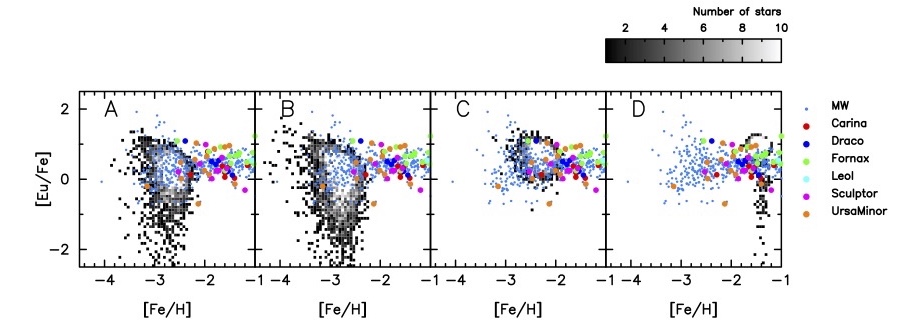Research Highlights
Early evolutionary histories of galaxies deduced from r-process elements
Abundances of r-process elements such as Eu and Ba in extremely metal-poor stars may reflect the early evolutionary histories of galaxies. However, how the chemo-dynamical evolution of galaxies affects the abundance of r-process elements is not yet understood. In this study, we perform a series of N-body/hydrodynamic simulations of galaxies with different density and mass. We calculate the evolution of r-process abundances in these galaxies. We find that galaxies with dynamical times around 100 Myr have star formation rates of less than 10
-3 Msun/year and they reproduce the observed r-process abundances (Figure A and B). This result does not depend on the mass of halos. On the other hand, r-process elements appear higher metallicity in galaxies with dynamical times around 10 Myr (Figure C and D). We also find that galaxies with lower star formation rates need longer timescale to mix metals, resulting in larger dispersions of r-process abundance ratios. This study demonstrates that future observations of r-process
elements in extremely metal-poor stars will be able to constrain the evolutionary histories of galaxies.
(2017/02/20)

Figure: [Eu/Fe] as a function of [Fe/H]. Grey scale represents model prediction. From left to right, we plot models with initial dynamical times of 100 Myr (A), 70 Myr (B), 30 Myr (C and D). Model D has a different density profile with other models. Small and large dots are observed abundances in the Milky Way halo and dwarf galaxies.
“Early chemo-dynamical evolution of dwarf galaxies deduced from enrichment of r-process elements”
Yutaka Hirai, Yuhri Ishimaru, Takayuki R. Saitoh, Michiko S. Fujii, Jun Hidaka and Toshitaka Kajino
2017, Monthly Notices of Royal Astronomical Society, 466, 2474
[ADS]
[arXiv]
Origin of r-process elements in galactic chemodynamical evolution
The r-process is one of the main processes to synthesize elements heavier than iron. The r-process elements have been observed in metal-poor stars in dwarf galaxies and the Milky-Way halo, but astrophysical site(s) of r-process is not identified yet. Nucleosynthesis calculations suggest that binary neutron star mergers are the promising astrophysical site of r-process. In contrast, galactic chemical evolution studies without considering the formation process of galaxies pointed out that it is difficult to reproduce the observed r-process abundance in extremely metal-poor stars by neutron star mergers due to their long merger time and low occurrence rate. In this study, we performed a series of hydrodynamical simulations of dwarf galaxies assuming that neutron star mergers are the major astrophysical site of r-process. Our simulations reproduce the observed r-process abundance in extremely metal-poor stars by neutron star mergers with merger time of 100 Myr. In addition, we find that the metallicity is constant over ~ 300 Myr from the onset of star formation due to low star formation efficiency in dwarf galaxies. We moreover find that metal mixing in star-forming region avoids producing extremely r-process rich stars, which are inconsistent with the observation, due to the low rate of neutron star mergers. The r-process elements observed in the Milky-Way halo might originate in accreted dwarf galaxies.
(2015/11/24)

"Enrichment of r-process Elements in Dwarf Spheroidal Galaxies in Chemo-dynamical Evolution Model", Yutaka Hirai, Yuhri Ishimaru, Takayuki R. Saitoh, Michiko S. Fujii, Jun Hidaka and Toshitaka Kajino
2015, The Astrophysical Journal, 814, 41
[ADS]
[arXiv]

